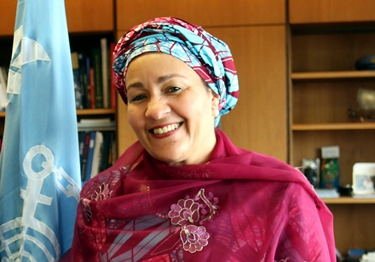UN Deputy Secretary General, Ms. Amina J. Mohammed
It’s your road, and yours alone, others may walk it with you, but no one can walk it for you.
Rumi
I recently returned from an official visit to five Central Asian countries – Kazakhstan, Kyrgyzstan, Tajikistan, Turkmenistan, and Uzbekistan – where I saw first-hand concrete actions after 30 years of independence to meet the manifold challenges facing a region full of profound complexities and great potential.
An international conference in Dushanbe, Tajikistan focused on water for sustainable development formed a cornerstone of my visit.
Water is a catalyst for peace and cooperation within the Central Asia region, and across borders with Afghanistan. The countries of Central Asia are harnessing water for green energy, climate-smart agriculture and improved access to drinking water.
I witnessed their determination to advance the climate agenda with a strong commitment to multilateral solutions to enhance water resource management.
The Aral Sea was once the fourth-largest lake in the world. Misplaced agricultural irrigation projects decades ago, coupled with rising temperatures, shrank the sea to just 10% of its original surface by the end of the 1990s.
The Aral Sea climate catastrophe stretches far beyond national or regional lines. It is a global tragedy.
The UN General Assembly declared the Aral Sea region a zone of ecological innovation and technologies, framing the region’s aspirations to invest in climate mitigation and adaptation as potential solutions for the world.
Regional climate action is critical. Global warming is accelerating the melting of Central Asia’s glaciers, which play a vital role in the region’s water and ecosystem balance.
The glaciers in Central Asia have receded by 25 percent in the last fifty years – with an equal amount expected to disappear in the next two decades.
This is yet another reason for global action to urgently reduce emissions and meet the Paris Climate Agreement’s goals of limiting temperature rise to 1.5°C.
The Kyrgyz Republic has declared 2022 the Year of Protection of Mountain Ecosystems and Climate Resilience. I heard a clear commitment from the leaders of all five countries to do their part.
The lack of financing is a serious obstacle to “greening” the region’s economies and conserving and restoring natural wealth, but ambition is notable.
A greener economy combined with digitalization, will not only modernize the economies but also create new job opportunities in sectors that match global needs.
It is also essential to rethink the region’s economic development pathway to make the most of the region’s demographic change. Central Asia is home to 76.5 million people, and that population is young – the median age is 27.6 years.
I visited the Central Asia University which provides the youth of the region opportunities not only to learn and grow intellectually, but also to establish the friendships and networks that will help advance regional growth and peace in the future.
The youth I met throughout Central Asia shared with me their determination to shape their economies in productive ways – with emigration no longer having to be a default choice for many – and to have a seat at the table with their voices heard.
I heard a similar message from women of all ages. They made a clear call for faster and far greater progress towards more equal and inclusive societies that ensure women’s economic empowerment, women’s rights and leadership.
The global silent pandemic of gender-based violence, also presents a challenge which Central Asia must overcome including discriminatory practices, outdated societal norms, patriarchal attitudes and stereotypes in an effort to achieve full gender equality. This is essential to realize the contribution of Central Asia’s women to the region’s societal and economic transformation.
In particular, digitalization offers an important pathway for connectivity, transforming education, improved governance and expansion of economic opportunity and inclusion. With greater efforts for openness and reform, there is unlimited potential for Central Asian economies.
As with societies everywhere, an essential ingredient for social and economic transformation is strengthening human rights. While I see the glass as “some full,” the United Nations is keen to work together and support the countries of Central Asia fill the rest. Human rights must be at the centre and in the outcomes of all investments in the people of the region.
As we accompany the people of the region on this journey, the United Nations will continue to represent and amplify the voices of the marginalized and vulnerable and offer solutions to achieve equality, justice and inclusion, cornerstones for sustainable development and sustaining peace in the region. In a region where borders are new, consensus is urgently needed to overcome tensions around disputed lines, paving the way for sustainable peace and regional economic and social growth.
Taking action to prevent the spread of violent extremism and mitigate the impacts for people and economies of the war in Ukraine will require meticulous attention and upholding the rule of law, including international human rights law.
Despite the many challenges, I left Central Asia full of hope. Change is happening. Challenges are being grasped.
It is led by the vibrant young majority of the population who aspire to protect and nurture the beauty of the region’s natural environment and usher in social and economic changes.
All of this can help assure an inclusive and sustainable future for all the people of Central Asia. ///UN Turkmenistan
